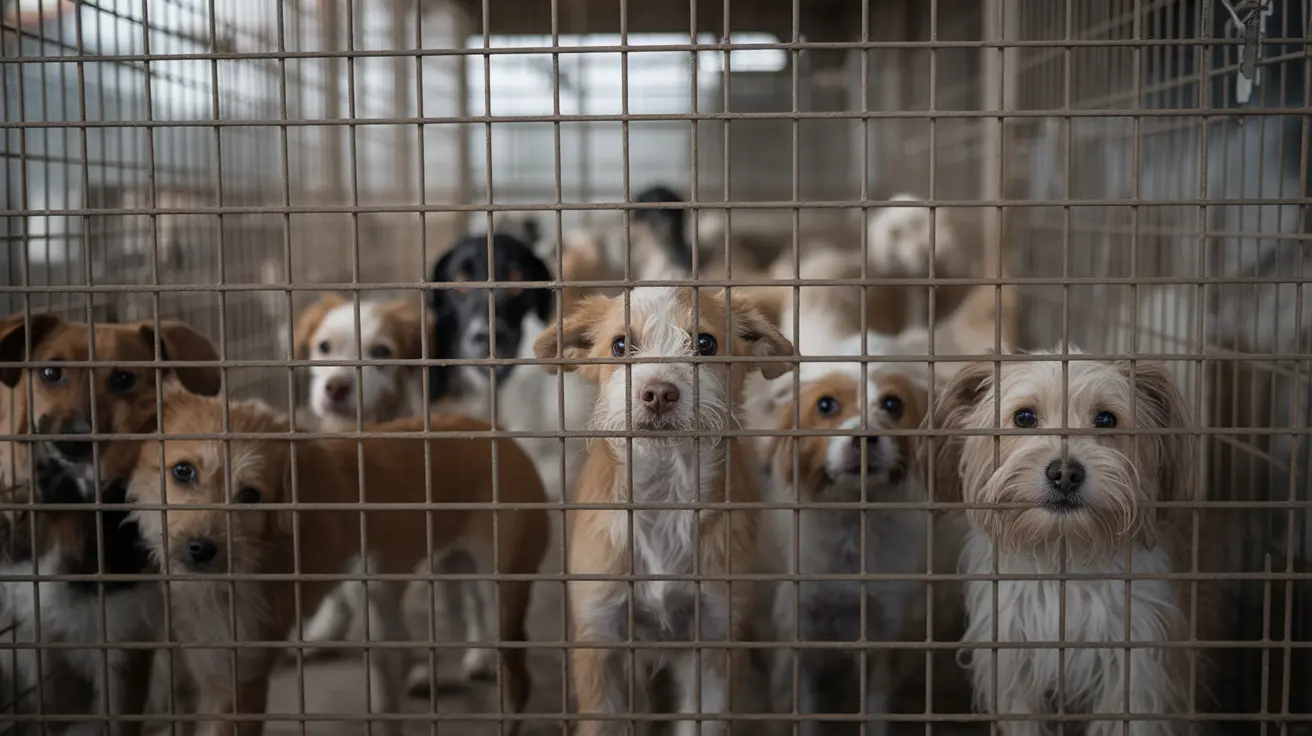Dog Skin Cancer Symptoms and Treatment: A Complete Guide for Pet Owners
Dog skin cancer represents one of the most frequently diagnosed malignancies in canines, affecting thousands of pets across the United States each year. As a responsible pet owner, understanding the symptoms, treatment options, and prevention strategies for skin cancer can make the difference between early intervention and advanced disease progression. While the diagnosis of cancer in your beloved companion can feel overwhelming, knowledge empowers you to take swift action and work with your veterinary team to provide the best possible care.
This comprehensive guide will walk you through everything you need to know about dog skin cancer symptoms and treatment, from recognizing the earliest warning signs to understanding the various therapeutic approaches available. We'll explore the different types of skin cancer that affect dogs, discuss breed-specific risk factors, and provide practical advice for conducting home skin examinations that could save your pet's life.
Understanding Different Types of Dog Skin Cancer
Not all skin tumors in dogs are malignant, but understanding the various types helps pet owners recognize potential warning signs early. Skin cancer in dogs is characterized by abnormal growth of cells in the skin, and while benign tumors do not spread to other parts of the body, malignant tumors require immediate attention and comprehensive treatment.
Mast Cell Tumors: The Most Common Threat
Mast cell tumors represent the most common skin cancer in dogs, arising from immune system cells that can occur anywhere on the skin or internal organs. These tumors are particularly concerning because they can change size and cause inflammation, making them sometimes difficult to distinguish from benign growths initially. Breeds at higher risk include Boxers, Boston Terriers, Bulldogs, Pugs, Rhodesian Ridgebacks, Golden Retrievers, and Labrador Retrievers. The symptoms typically manifest as raised lumps that may fluctuate in size and can cause surrounding tissue inflammation.
Malignant Melanoma: Aggressive and Fast-Spreading
Malignant melanoma in dogs is usually found in the mouth, nail beds, or mucous membranes, and these tumors are known for their rapid growth and tendency to spread to vital organs like the lungs and liver. This type of cancer is particularly aggressive and requires immediate veterinary intervention. Miniature and standard schnauzers, Scottish terriers, and male dogs generally face higher risk factors for developing malignant melanoma.
Squamous Cell Carcinoma: Sun-Related Cancer
Often linked to sun exposure, squamous cell carcinoma appears as firm, raised patches or lumps that can ulcerate over time. This type typically affects older dogs, particularly light-skinned or short-haired breeds such as whippets, Dalmatians, and bull terriers. The connection to UV exposure makes this cancer particularly preventable through proper sun protection measures.
Other Important Types
Histiocytic tumors commonly affect dogs under three years of age, often appearing in large breeds such as Labradors and Boxers. These present as small, round, pink masses that sometimes regress naturally without treatment. Fibrosarcoma originates from connective tissue beneath the skin and typically occurs in middle-aged to older dogs, potentially causing firm lumps that may be painful or ulcerated. Gordon Setters and Doberman Pinschers show increased susceptibility to fibrosarcoma.
Recognizing Dog Skin Cancer Symptoms
Early detection of skin cancer symptoms significantly improves treatment outcomes for dogs. Pet owners should be vigilant for various warning signs that may indicate the presence of malignant growths or other serious skin conditions requiring veterinary attention.
Primary Physical Symptoms
The most obvious dog skin cancer symptoms include new lumps, bumps, or growths that do not heal over time. These may appear as warty or raised lesions anywhere on your dog's body. Discolored or inflamed skin areas should also raise concern, particularly if they persist or worsen despite basic care measures. Sores or ulcers that fail to heal within a reasonable timeframe warrant immediate veterinary evaluation.
Secondary Warning Signs
Beyond visible skin changes, dogs with skin cancer may exhibit behavioral symptoms that indicate discomfort or pain. Lameness or signs of pain can occur when tumors invade deeper tissues, affecting your dog's mobility and quality of life. Swollen lymph nodes, which you may feel as enlarged lumps under your dog's neck, armpits, or groin area, can indicate that cancer has begun to spread.
Systemic Symptoms to Monitor
Changes in normal skin texture or hair loss in specific areas can signal underlying malignancy. Excessive licking or scratching of particular spots may indicate irritation caused by developing tumors. For cancers affecting the mouth or throat area, you might notice difficulty eating or swallowing. Eye abnormalities or unusual growths around the eyes require immediate attention, as do any general signs such as lethargy, unexplained weight loss, and decreased appetite.
Risk Factors and Breed Predispositions
Understanding the risk factors for dog skin cancer helps pet owners take preventive measures and remain vigilant for early symptoms. Environmental factors such as sun exposure, toxins, and chemicals significantly increase the risk, alongside genetic predispositions and hormonal abnormalities that vary by breed and individual factors.
Environmental Risk Factors
Sun exposure represents one of the most significant environmental risk factors for canine skin cancer, particularly for dogs with light skin or thin coats that provide less natural UV protection. Chemical exposure from lawn treatments, cleaning products, and industrial pollutants can also contribute to increased cancer risk. Dogs that spend considerable time outdoors without adequate protection face higher risks of developing sun-related skin cancers.
Breed-Specific Vulnerabilities
Certain breeds demonstrate higher susceptibility to specific types of skin cancer due to genetic factors and physical characteristics. Light-skinned breeds and those with short or thin hair coats face increased vulnerability to UV-related cancers. Additionally, some breeds carry genetic predispositions to particular cancer types, making regular screening especially important for these dogs.
Diagnostic Procedures for Skin Cancer
Accurate diagnosis of skin cancer requires comprehensive veterinary evaluation using multiple diagnostic tools and techniques. The diagnostic process typically begins with a thorough physical examination and progresses to more specific testing procedures to determine the exact type and extent of any malignancy.
Initial Veterinary Assessment
Diagnosis involves a complete veterinary examination that includes careful palpation of all accessible lymph nodes and a systematic evaluation of your dog's entire skin surface. Your veterinarian will document the size, location, and characteristics of any suspicious growths, and may photograph lesions to track changes over time.
Advanced Diagnostic Techniques
Fine needle aspiration (FNA) represents a minimally invasive diagnostic tool that allows veterinarians to collect cells from suspicious masses for microscopic examination. When FNA results are inconclusive, a surgical biopsy provides more comprehensive tissue samples for definitive diagnosis. Imaging studies including X-rays, CT scans, or MRI may be necessary to assess tumor extent and identify potential metastasis to internal organs.
Importance of Early Biopsy
Early biopsy and pathological examination are critical for developing an accurate diagnosis and appropriate treatment plan. These procedures allow veterinary pathologists to identify the specific type of cancer, assess its aggressiveness, and determine the most effective treatment approach for your individual dog's situation.
Comprehensive Treatment Options
Treatment options for dog skin cancer depend on multiple factors including tumor type, location, staging, and your dog's overall health status. Modern veterinary oncology offers various therapeutic approaches that can be used individually or in combination to provide the best possible outcomes.
Surgical Interventions
Surgery often represents the first-line treatment for many types of skin cancer, aiming to remove tumors completely with clear margins of healthy tissue. The extent of surgical intervention varies from simple excision of small tumors to more complex procedures that may require plastic surgery techniques for reconstruction. In cases where tumors affect limbs and cannot be completely removed otherwise, amputation may be necessary to prevent further spread.
Chemotherapy Protocols
Chemotherapy is typically recommended for tumors with high metastatic potential or when surgical removal alone is insufficient. These medications work by targeting rapidly dividing cancer cells throughout the body, helping to control disease progression and improve quality of life. Your veterinary oncologist will develop a customized chemotherapy protocol based on your dog's specific cancer type and overall health status.
Radiation Therapy Applications
Radiation therapy proves particularly valuable for treating tumors in locations where complete surgical removal is difficult or impossible. This treatment modality uses high-energy radiation beams to destroy cancer cells while minimizing damage to surrounding healthy tissue. Radiation therapy can be used as a primary treatment or in combination with surgery and chemotherapy.
Innovative Treatment Approaches
Immunotherapy represents an exciting advancement in veterinary oncology, particularly for specific tumor types like melanoma. These treatments work by stimulating your dog's own immune system to recognize and attack cancer cells more effectively. While not appropriate for all cancer types, immunotherapy can provide significant benefits for eligible patients.
Prevention Strategies and Home Monitoring
Prevention focuses on reducing known risk factors and implementing regular monitoring practices that enable early detection when treatment is most effective. Pet owners play a crucial role in prevention through environmental management and consistent health surveillance.
Sun Protection Measures
Limiting sun exposure for dogs with light skin or thin coats represents one of the most effective prevention strategies. This includes providing adequate shade during outdoor activities, scheduling walks during cooler parts of the day, and using canine-formulated sunscreens when appropriate. Never use human sunscreen products on dogs, as many contain ingredients that are toxic to pets.
Regular Home Examinations
Pet owners should routinely examine their dogs' skin and promptly consult a veterinarian if any suspicious signs appear. Effective home examinations involve systematically checking your dog's entire body, including areas that are often overlooked such as between toes, inside ears, and around the genital area. Document any new growths or changes in existing skin features with photographs and notes about size, color, and texture.
Professional Veterinary Care
Regular veterinary checkups provide professional assessment of your dog's skin health and early detection of potential problems. Veterinary professionals have the training and experience to identify subtle changes that pet owners might miss, and they can recommend appropriate diagnostic procedures when necessary.
Prognosis and Quality of Life Considerations
The prognosis for dogs with skin cancer varies significantly based on tumor type, stage at diagnosis, and timeliness of treatment intervention. While some skin cancers carry excellent prognoses with appropriate treatment, others require ongoing management and careful monitoring to maintain quality of life.
Factors Affecting Prognosis
Benign tumors often have excellent outcomes following complete surgical removal, while malignant tumors require comprehensive management and ongoing monitoring for recurrence or metastasis. Early detection and treatment significantly improve outcomes across all cancer types, emphasizing the importance of regular health surveillance and prompt veterinary consultation for suspicious changes.
Long-term Management
Dogs diagnosed with skin cancer often require long-term follow-up care including regular examinations, periodic imaging studies, and laboratory monitoring. Your veterinary team will develop a customized surveillance plan based on your dog's specific situation, helping to detect any recurrence or new primary tumors as early as possible.
Frequently Asked Questions
- What are the earliest signs of skin cancer in dogs that owners should watch for?
The earliest signs include new lumps or bumps that appear anywhere on the skin, persistent sores that don't heal within a few weeks, changes in the color or texture of existing skin areas, and any growths that seem to be getting larger or changing in appearance over time. - How often should I examine my dog's skin for signs of cancer?
You should perform a thorough skin examination on your dog at least once a month, checking all areas including between toes, under the tail, inside the mouth, and other easily overlooked spots. During regular grooming sessions, take extra time to feel for any new lumps or changes in your dog's skin. - Are certain dog breeds more susceptible to skin cancer than others?
Yes, certain breeds face higher risks for specific types of skin cancer. Boxers, Boston Terriers, and Golden Retrievers are more prone to mast cell tumors, while light-skinned breeds like Dalmatians and Whippets face increased risk for sun-related squamous cell carcinoma. Scottish Terriers and Schnauzers show higher susceptibility to malignant melanoma. - Can skin cancer in dogs be prevented completely?
While complete prevention isn't possible due to genetic factors, you can significantly reduce your dog's risk by limiting sun exposure, using pet-safe sunscreen on light-skinned dogs, avoiding chemical exposures when possible, and maintaining regular veterinary checkups for early detection. - What should I do if I find a suspicious lump on my dog?
Schedule a veterinary appointment promptly for professional evaluation. While you wait for the appointment, monitor the lump for changes in size, color, or texture, and avoid manipulating or irritating the area. Take photos to document the appearance and location for your veterinarian. - How expensive is skin cancer treatment for dogs?
Treatment costs vary widely depending on the type of cancer, staging, and chosen treatment approach. Simple surgical removal might cost hundreds of dollars, while comprehensive treatment involving chemotherapy or radiation therapy can range into thousands of dollars. Discuss treatment options and associated costs with your veterinary team to make informed decisions. - Is skin cancer painful for dogs?
Some types of skin cancer can cause discomfort or pain, particularly when tumors grow large, ulcerate, or invade deeper tissues. Signs of pain might include excessive licking or scratching of the affected area, reluctance to be touched, changes in behavior, or lameness if tumors affect the limbs.
Conclusion
Understanding dog skin cancer symptoms and treatment options empowers pet owners to take proactive steps in protecting their canine companions from this common health threat. Early detection through regular home examinations and prompt veterinary consultation for suspicious changes significantly improves treatment outcomes and quality of life for affected dogs. While a cancer diagnosis can feel overwhelming, advances in veterinary oncology provide multiple treatment options that can effectively manage the disease and extend your dog's healthy, happy years.
Remember that prevention through sun protection, environmental awareness, and regular health monitoring represents your first line of defense against canine skin cancer. By staying informed about risk factors, maintaining consistent examination routines, and working closely with your veterinary team, you can help ensure that any potential skin cancer is detected and treated as early as possible, giving your beloved pet the best possible chance for a positive outcome.






